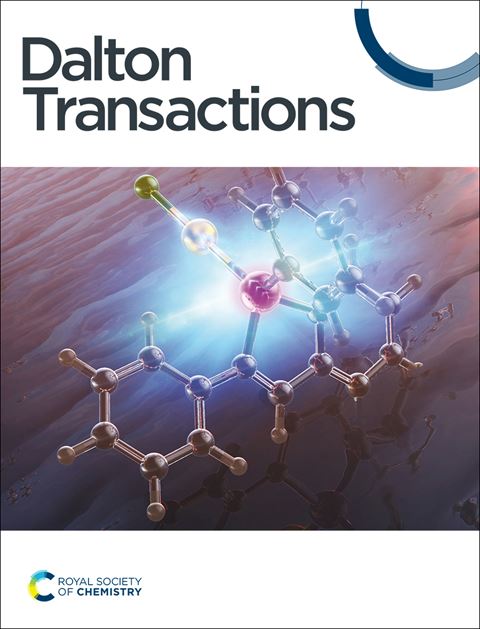Synthesis and characterisation of uniform CoPt nanoparticles using red blood cell ghosts conjugated with peptides on their inner surface
IF 3.5
3区 化学
Q2 CHEMISTRY, INORGANIC & NUCLEAR
引用次数: 0
Abstract
Hybrids of metal nanoparticles (NPs) and lipid vesicles are attractive materials in a wide variety of fields including catalysis, sensing, and biomedical applications. Lipid vesicles can entrap metal NPs on their surfaces, in the lipid bilayer, or within their aqueous cores, resulting in the stabilisation of metal NPs in aqueous environments. Metal NP-lipid vesicle hybrids have been prepared using lipid film hydration in the presence of colloidal metal NPs and in situ synthesis of metal NPs within lipid vesicles. Although these methods are useful for preparing metal NP-lipid vesicle hybrids, they generally suffer from low yield, poor selectivity, and low purity. Moreover, it is still difficult to precisely control the formation process of metal NPs, and the nanospace of lipid vesicles is too small to deposit a large number of metal NPs. We described here the design of a red blood cell ghosts (RBCGs), micro-sized biological membranes, for the synthesis of bimetallic cobalt-platinum nanoparticles (CoPt NPs) with diverse functions such as excellent magnetic properties and catalytic activities. RBCGs are red blood cells from which cytoplasmic components are removed by hypotonic haemolysis. Notable structural features of RBCG include biconcave hollow vesicles with large volume and surface area and the presence of a cytoskeleton composed of proteins beneath the inner membrane. The cytoskeleton allows the immobilisation of various functional molecules on the internal surface by the chemical modification. To deposit uniform CoPt NPs on the inner surface of RBCG, we fabricated RBCG in which a CoPt-binding peptide was chemically attached to the RBCG cytoskeleton. In situ synthesis of CoPt NPs was performed using peptide-conjugated RBCGs or RBCGs under the various conditions. Metal quantification, TEM and magnetic measurement reveal that CoPt NPs prepared using peptide-conjugated RBCGs have larger and uniform NPs with higher Co content than those prepared using RBCGs, resulting in improved magnetic properties.利用内表面结合多肽的红细胞鬼影合成和表征均匀CoPt纳米颗粒
金属纳米颗粒(NPs)和脂质囊泡的混合物在催化、传感和生物医学应用等广泛领域都是有吸引力的材料。脂质囊泡可以在其表面、脂质双分子层或其水核中捕获金属NPs,从而在水环境中稳定金属NPs。在胶体金属NPs存在的情况下,利用脂质膜水合作用和在脂质囊泡内原位合成金属NPs制备了金属np -脂质囊泡杂化体。虽然这些方法对制备金属np -脂质囊泡杂合体很有用,但它们通常存在产率低、选择性差和纯度低的问题。此外,精确控制金属NPs的形成过程仍然很困难,脂质囊泡的纳米空间太小,无法沉积大量的金属NPs。我们在这里描述了一种红细胞鬼(RBCGs)的设计,微尺寸的生物膜,用于合成具有多种功能的双金属钴-铂纳米颗粒(CoPt NPs),如优异的磁性和催化活性。红细胞是通过低渗溶血去除细胞质成分的红细胞。RBCG的显著结构特征包括体积和表面积大的双凹中空囊泡,以及在内膜下存在由蛋白质组成的细胞骨架。细胞骨架允许通过化学修饰在内表面固定各种功能分子。为了在RBCG的内表面沉积均匀的CoPt NPs,我们制造了RBCG,其中CoPt结合肽化学附着在RBCG的细胞骨架上。在不同条件下,使用肽偶联的RBCGs或RBCGs进行CoPt NPs的原位合成。金属定量、透射电镜和磁性测量结果表明,肽偶联RBCGs制备的CoPt NPs比RBCGs制备的NPs更大、更均匀,Co含量更高,从而提高了其磁性能。
本文章由计算机程序翻译,如有差异,请以英文原文为准。
求助全文
约1分钟内获得全文
求助全文
来源期刊

Dalton Transactions
化学-无机化学与核化学
CiteScore
6.60
自引率
7.50%
发文量
1832
审稿时长
1.5 months
期刊介绍:
Dalton Transactions is a journal for all areas of inorganic chemistry, which encompasses the organometallic, bioinorganic and materials chemistry of the elements, with applications including synthesis, catalysis, energy conversion/storage, electrical devices and medicine. Dalton Transactions welcomes high-quality, original submissions in all of these areas and more, where the advancement of knowledge in inorganic chemistry is significant.
 求助内容:
求助内容: 应助结果提醒方式:
应助结果提醒方式:


